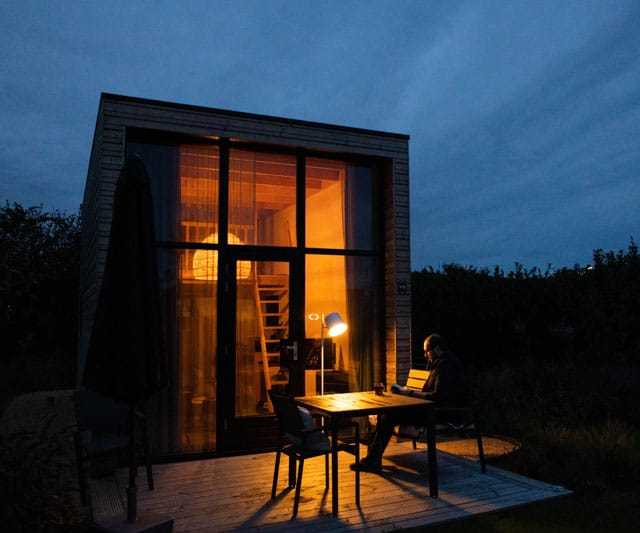About a decade ago, Megan Parrish began worrying about her mother, Pat Dalrymple. Dalrymple, now 68, was living alone in Lake Arrowhead, a mountainous resort area in California, and her house was becoming too much for her to handle. “I knew Mom was having a hard time,” Parrish recalled. So she floated the idea of her mother moving to be near her and her husband, Sam. Soon the three of them were in search of a way to keep Dalrymple close — but not too close.
Their solution was to build Dalrymple a small home literally in the Parrishes’ backyard. Dalrymple sold the California house to fund the construction, and in 2014 she downsized into a custom-designed, 740-square-foot house that suits her needs perfectly. It is light and airy, with dark wood floors, creamy yellow walls, vaulted ceilings and lots of windows.
Dalrymple loves the setup. She hosts big family gatherings — “We push all the furniture against the walls” — and regularly invites a gaggle of neighbors over for game nights. Designed to be senior friendly, the place features wide doorways, a no-step entry and a low-curb shower. The biggest perk is that she is just steps away from her 3-year-old granddaughter, Quinn, who toddles easily between the two homes. It’s the kind of grandma access that makes Dalrymple’s friends envious.
This story is a common one across Portland, Oregon. Since around 2010, the city has been encouraging the development of such accessory dwelling units, or ADUs — modest living spaces (800 square feet, tops) that share property with a main house. ADUs, whether stand-alone or connected to the main house, are being embraced by a growing number of cities and states in response to their lack of affordable housing. The California Legislature, for one, has gone all in on them, passing a series of bills to encourage development statewide.
More particularly, ADUs are seen by experts on aging as a promising tool for addressing a critical shortage of housing for older Americans. AARP, the research and advocacy behemoth, has begun aggressively promoting the spread of these units, often referred to as casitas or, more cheekily, granny flats. This is good news — and not just for older folks. With America’s population growing steadily grayer and with the ongoing shift away from institutional care toward aging in place, the demand for senior-friendly housing is set to rise for years to come. We as a society need to be rethinking our housing needs and working toward creative solutions. ADUs are just one piece of a sprawling, dizzyingly complex puzzle.
“We just don’t have the right range of housing options in this country,” says Rodney Harrell, a vice president at the AARP Public Policy Institute.
Harrell means a few things by this. For starters, most housing in the United States was not built with older residents in mind. Since World War II, residential development has revolved around car culture, encouraging sprawl and low-density development dominated by single-family homes. But while suburban enclaves may be great for raising children, they are an awkward fit for seniors, especially as driving becomes difficult or impossible. Older Americans are also particularly vulnerable to isolation and loneliness, which can be exacerbated by the atomized nature of suburban living.
The houses themselves are a problem as well. A young family’s dream home does not necessarily make sense for people in their 70s, 80s or beyond. Big yards, stairs, narrow doorways, high cabinets and even doorknobs can become daunting as time marches on. Only around 10% of the nation’s housing stock is considered senior friendly.
Now factor in America’s dearth of any kind of affordable housing, much less senior-friendly options. Homelessness is on the rise among older Americans, and close to one-third of senior households are considered cost burdened by housing, meaning they spend more than 30% of their income on it. (Renters suffer most.)
There is no silver bullet for this deeply entrenched, multipronged problem, but there are ways to make it better. Some solutions are more ambitious than others, and many are already being tried in various states and localities, including ADUs, cohousing developments (designed to encourage a mix of older and younger people), age-friendly modifications and so on. As Harrell puts it, “We need a Swiss Army knife approach, with lots of different tools.”
Some of these call for policy changes. Just as vital is a shift in mindset among community leaders, developers and the general public. America is no longer a young nation, and its approach to housing needs to adjust to meet this new reality.
Housing experts often talk about the missing middle — a lack of investment in buildings that have more units than a single-family home but are less dense than midrise apartments. Townhouses, garden apartments, duplexes and triplexes fell out of favor after World War II, in part because of restrictive zoning laws imposed by local governments, many of which were looking to keep out poor people and minorities.
Some cities have begun working to reverse that trend by expanding the housing stock in established communities. Portland and other West Coast cities have been leaders in the effort, experimenting with measures such as loosening zoning restrictions, streamlining permitting processes, establishing design standards, offering incentives for development and so on. In 2021, ADUs accounted for an estimated 15% of housing units approved statewide in California.
ADUs have captured the imagination of aging-in-place advocates because of their flexibility. They can easily accommodate seniors, family caregivers or paid home-care workers. Or retired homeowners can simply rent them out for extra income.
The units are not cheap to build, commonly costing in the low to middle six figures. Some areas are experimenting with ways to increase access for lower-income residents. San Diego has a program allowing homeowners to put multiple units on their property, as long as one of every two is maintained as low-income or affordable housing for a set number of years.
For the more communal minded, intergenerational housing communities aim to foster ties between older residents and younger families. Seniors serve as a stabilizing force, while the young people supply a jolt of dynamism.
Dale Allen moved into the cohousing community Cully Grove with his wife, Suzanne Millies, a decade ago, not long after it opened in 2013 in northeast Portland. “Suzanne and I wanted a place where we were not with a bunch of old people, because we didn’t feel very old when we moved here,” he recalls.
Cully Grove and its sister community, Cully Green, sit directly across a quiet street from each other. These developments consist of private town homes, duplexes and triplexes clustered around shared spaces and amenities such as a playground, a community garden, a sauna, communal kitchens and so on. Residents host Monday potlucks, movie nights and an epic Halloween party, and they help one another with errands and household chores.
One of Portland’s more ambitious intergenerational housing ventures is Bridge Meadows, an affordable housing development that opened its first campus in 2011 in North Portland. The campus has 36 apartments of varying sizes, along with a communal kitchen and multipurpose room, a library, a basketball court and small lounges scattered throughout. Most units are reserved for residents ages 55 or older. The rest are for families affected by the foster care system.
The staff members work to knit residents together, organizing group events and mediating conflicts — say, when an elder offers a little too much advice to one of the foster moms. Activities range from tai chi classes to a twice-monthly group dinner.
Two early arrivals to the development were Stephney and Steve Huff, the only married couple among the facility’s elders. Like many older residents, they have taken on the role of surrogate grandparents to their young neighbors over the years. Elders help with everything from homework to art projects to driving kids to school and sports. Stephney Huff, a bubbly septuagenarian, recalls making a prom dress for one high schooler, while Steve Huff enjoys showing the kids how to fix their bikes and build stuff. The kids keep the elders current on music and technology and, more generally, give them a sense of purpose.
The older residents look after one another as well, and when age or infirmity takes a toll, people rally around. Since his wife died in 2021, Allen has taken solace in his Cully neighbors. “I’m lonely for her, but I feel so supported by this community,” he says, his voice wavering. “I just can’t imagine living anywhere else.”
For options like these to make a real dent in the housing shortage, many states and localities will need to revisit their housing policies. In too many places, restrictive zoning and other hurdles block the building of ADUs, duplexes and the like — or make them prohibitively difficult to develop.
Even in places that have already legalized ADUs and other options, related restrictions, such as parking and occupancy requirements, often hamstring development. Design standards need to be clarified. The approval process needs to be streamlined. Financing options for ADUs, in particular, need to catch up to the emerging market.
California offers a useful template for promoting change. Since 2016, when the state began passing a series of bills to encourage development of smaller housing options, the number of permits issued statewide for ADUs jumped from fewer than 1,300 in 2016 to more than 24,000 in 2022.
(BEGIN OPTIONAL TRIM.)
Other states should explore similar moves, urges Denise Pinkston, the board president of Casita Coalition, a nonprofit supporting the small-housing movement. “This has to happen at the state level,” she says. “Each city has only the interests of the people who already live there.”
Federal agencies also have a role to play. In April the Federal Housing Administration proposed reforming its guidelines to make it easier for more people to obtain loans for ADUs or for houses that already include a unit. This move makes sense and should be encouraged.
NIMBYism remains a significant hurdle. But as the status quo grows increasingly unsustainable, filling in that missing middle will expand housing in a gentler way than adding high-rise apartment buildings.
More focus on (and investment in) upgrading the existing housing stock is also needed. Many homes require significant modifications to make them safe for seniors, but the price of such modifications can quickly spiral. Medicaid provides some level of help, and some outside organizations are getting into the act. Since 2018, Habitat for Humanity of Greater Memphis in Tennessee has provided critical home repairs and modifications to area seniors. But again, the level of need is daunting.
This is not a zero-sum game. Many efforts to expand housing options for seniors can expand them for everyone. Plus, the burdens of seniors’ housing woes, financial and otherwise, tend to fall on the shoulders of younger family members.
The Parrishes seem sold on the ADU model for the foreseeable future. They have started talking about what happens when their family outgrows their current home. But whenever they look around, Parrish says, they “look for things that have room to build another ADU — or that already have one.”
This article originally appeared in <a href=”https://www.nytimes.com/2023/09/06/opinion/seniors-housing-adus.html”>The New York Times</a>.







